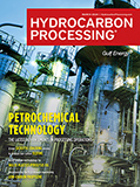Treating
Speed up the development of new commercial adsorbents—Part 1
In the conventional development approach, a multi-stage process begins in the laboratory, moves to the pilot plant, and ends at the commercial unit, often before any financial benefits are realized.
Aqueous chemistry principles applied to refinery processes
In the petroleum refining industry, pH measurement and adjustment are extremely important.
Modeling and optimization of pressure distillation to achieve pharma-grade THF
This case study details the production of tetrahydrofuran (THF), with a purity of 99.96 wt% and water moisture of less than 200 parts per million (ppm).
Industry Perspectives: Secondary unit construction surges in the near term
Although the refining industry is expected to add more than 7 MMbpd of new distillation capacity by the early 2020s, the global refining industry will witness a boost in secondary processing capacity, as well.
Editorial Comment: The future of refining—sulfur need not apply
According to multiple industry reports, crude oil consumption will continue to increase over the short term.
Cost-effective revamp of CO2 removal systems
The cost-effective revamp experiences of carbon dioxide (CO<sub>2</sub>) removal systems in three different ammonia plants, and the resulting attractive payback of just a few months are detailed here.
Flexibility in desalting operations for opportunity crudes
Typically, opportunity crudes require more rigorous desalting to yield high-quality products due to high levels of naphthenic acids, basic sediment and water (BS&W) and filterable solids, among others.
Upgrading the bottom of the barrel
In the past few decades, new technologies, including both carbon rejection methods and catalytic conversion methods, have emerged.
Optimize LNG production through contaminant mitigation—Part 2
The production of liquefied natural gas (LNG) requires a number of stages to effectively purify the feed gas. These stages are essential to maintain continuous operation and to meet product specifications. Liquid and solid contamination issues are common in many feed gas purification operations and can cause severe problems with equipment fouling, leading to additional expenses in maintenance and equipment repair, reduced production capacity and even unscheduled shutdowns.
2018 Industry Leaders’ Viewpoints
To kick off the new year, industry leaders and esteemed colleagues shared their viewpoints on 2018 and beyond with Hydrocarbon Processing. These viewpoints offer insight into growing regions of activity, technological advances, and how the downstream industry can innovate in 2018 and into the future.

- Meridian Energy Group’s Davis Refinery Project in North Dakota (U.S.) will be the world’s first net-zero carbon refinery 4/17
- Lummus expands R&D capabilities to enhance innovation and water and wastewater technologies 4/17
- Niger plans to build diesel refinery and increase supplies to Mali 4/17
- BASF, SABIC, and Linde celebrate the start-up of the world's first large-scale electrically heated steam cracking furnace 4/17
- U.S. crude stocks rise, gasoline, distillate inventories fall 4/17
- Russia's offline primary oil refining capacity revised up for April 4/17




